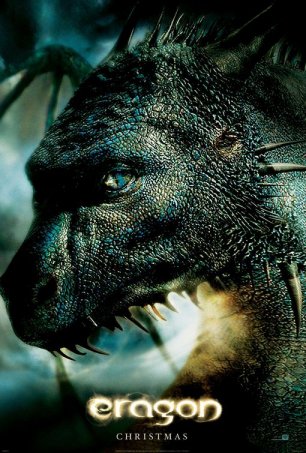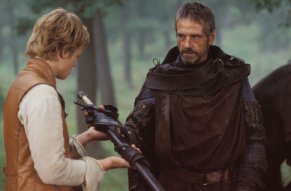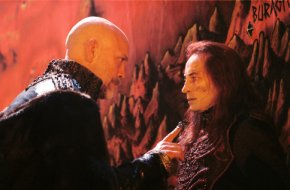|
Eragon
“Eragon?
Sounds like that guy from LOTR for some reason.” Not
knowing much about the series of dragon novels written by
(once upon a time) 15-year-old Christopher Paolini,
I went into the screening for Eragon pretty much
blind, but I found exactly what I’d expected to encounter.
The
film is about a young ambitious farm boy named Eragon (Edward
Speleers) who stumbles into a wild and fantastic adventure.
Whisked away from farm life after everything he loves is
destroyed by an evil empire, he must follow a sage-like
guide named Brom (Jeremy Irons) on a quest to learn magical
powers, harness his true capability, and lead heroic groups
into battle against the evils of his world.
It all
begins in a galaxy far, far, away… well, not really.
You can’t fault Eragon for its Joseph Campbell-esque
foundation, although the similarities between Lucas’
own farm boy-turned-hero adventures are striking. Paolini’s
novels likely pull from similar reference material, but
changes things about by including the legendary partnerships
between dragons and mankind.
The
filmed adaptation, however, can be rightly faulted for its
take on the story. The film feels less like an adaptation
of a novel and more like an obscure mash-up experiment.
It’s as if they took the film versions of the Lord
of the Rings and the Harry Potter novels, tossed them
into a box with A New Hope and some dragons, and
then shook them around a bit. Voila! A genius attempt
by the studio’s marketing execs to cash in on the
youth fantasy trilogy market.
In fact,
this film feels so positioned and ripped-off that one can’t
help but notice the similarities among other filmed counterparts.
Uncle Garrow’s death, the discovery of Brom’s
past, defending the Varden stronghold deep in the Beor Mountains,
the mysterious introduction of Murtagh, and the inevitable
death of Obi Wan – er, I mean Brom.
The
disappointment here isn’t that prevalent and obvious
fantasy and sci-fi elements are being used; every genre
has its staples that you expect to be used. Instead, the
feeling of been-there-done-that is only enhanced by the
decision to emulate the way these genre motifs were re-created
in other films. It can’t be called homage, so don’t
even go there.
The
film feels like it wanted to attempt the sort of grand scale
of Peter Jackson’s Rings Trilogy, but then
someone decided to trim all exposition and substance in
exchange for cutting to the chase. Characters move in directions
for reasons unbeknownst to the audience. If you were to
pause the film and ask Jeremy Irons for his character’s
motivation for finding the Varden, a likely response would
be that it says to do so in the script.
Speaking
of inconsistencies, at one point Eragon mounts Saphira (voiced
by Rachel Weisz) and the two of them take flight. Brom rides
horseback and encounters a few Ra’zac (read: Ringwraiths)
in the forest ahead. This becomes complicated later when
Brom states that no horse can outrun a dragon. Perhaps Brom
knows something we don’t.
The
script also struggles from far too much use of convenience
to remedy situations. When Brom is fatally injured, Eragon
attempts to use magic to heal his wounds. Brom tells him
that he is not yet strong enough to do so, but he will be
in time. Eragon spends very little time developing his use
of magic between this scene and his next opportunity to
heal. In fact, as a character he has barely developed, and
no apparent progress has been made in this arena. At least
Luke had to learn how to move rocks on Dagobah before using
the Force more effectively.
Of course,
when the time comes, his healing powers work like a charm,
brilliantly setting up a sequel that can be chock full of
stunted plotlines and tired tropes. We see so little of
John Malkovich as King Galbatorix, who is ultimately reduced
to pounding his fist upon a throne in cutaway sequences.
Robert Carlyle is mildly amusing as Durza, but ultimately
you just don’t care.
When
describing the film to another friend the day after screening
it, he responded with, “It figures, they pretty much
made the movie to follow the video game as a tie-in.”
That’s when it struck me. The film feels like an adaptation
of a weak, knock-off, movie-tie-in video game. If that’s
what it was aspiring to achieve, then it’s done so
in spades.
Rating:

|








